The oldest land plants (II) (I)
Spiny plants
During the Early Devonian (405 - 385 million years ago) several other
groups of plants developed. They had the common feature of being rather small
(not higher than half a meter) and simply structured.
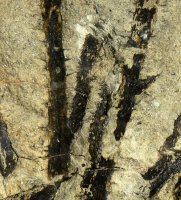

Thus the plant Sawdonia ornata had no leaves,
but it did have spines. The function of the spines was probably to enlarge
the surface for the assimilation of carbon dioxide from the air. They were
not needed for defense for the first vertebrate land animals (the amphibians)
did not appear before the Middle Devonian. Possibly the plants formed thick
shrubberies using the spines as a hold.
Another spiny plant from the Early Devonian is
Drepanophycus spinaeformis. This one had
a thicker stem with firm spiny leaves. The stems are often found without
the spines. In this case the scars will be visible.
The compressed fossils of Devonian plants scarcely give any information.
Determining these very old plants is extremely difficult as hardly anything
shows on the fossils. Only stems, bifurcations and possibly spines. With
luck you find sporangia. In that case it might be possible to detect the
name of the plant. Sometimes the cuticle has stayed intact. After chemical
treatment it is possible to make a microscope preparation of it in which
e.g. cells and stomata are visible.
T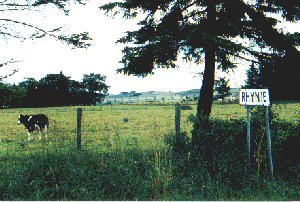 he discovery of a silicified
moor near the Scottish village of Rhynie, 40 km north-east of Aberdeen, has
revealed a lot about the structure of very old plants. he discovery of a silicified
moor near the Scottish village of Rhynie, 40 km north-east of Aberdeen, has
revealed a lot about the structure of very old plants.
About 400 million years ago, in the beginning of the Devonian, there was
a kind of Yellowstone park with vulcanos and geysers at that location. Some
of the geysers spouted boiling, siliceous water with intervals of a couple
of years which caused the vegetation, including the underlying peat layers,
to silicify. The fossils in this so called Rhynie Chert are so perfect that
the plants can be studied within the accuracy of cell structure level. It
is possible to make very thin slices of the fossil bearing chert, which can
be viewed under the microscope.
The Rhynie Chert was discovered in 1912 by the geologist Dr. W. Mackie.
The paleobotanists R.
Kidston and W.H. Lang
have published a very extensive description of the plants and the fungi in
the chert from 1917 to 1922. In the last decades many new discoveries have
been made. |
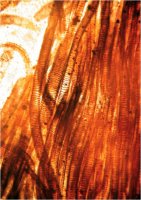 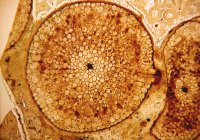 The photo on the right
shows a section of the stem of the most common plant,
Rhynia. The diameter of the stem is in reality
1.3 mm. By clicking the photo you can see a stoma of this plant as well,
complete with two closing cells. The state of conservation is extremely good.
Rhynia is very close to the primeval plant from which most of the
modern plants have originated. The photo on the right
shows a section of the stem of the most common plant,
Rhynia. The diameter of the stem is in reality
1.3 mm. By clicking the photo you can see a stoma of this plant as well,
complete with two closing cells. The state of conservation is extremely good.
Rhynia is very close to the primeval plant from which most of the
modern plants have originated.
A second plant common
in the Rhynie Chert is called
Asteroxylon. It is a very early member of
the clubmoss group. In the picture on the left you can see the wood vessels
of this plant, reinforced with annular and spiral thickenings.
 
|
Further developments
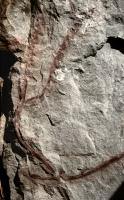  From the Early Devonian the flora evolution gains momentum. Wereas the number
of species in the Late Silurian could be counted on the fingers of two hands,
in the Early Devonian this has become quite impossible. Yet at that moment
the number of species was still very limited and in many cases the vegetation
at a certain spot consisted of only one species or a very small number of
species. At the rare finding places of well-preserved Early Devonian plant
fossils one often tends to find one dominating species with the occasional
sparse occurrence of other species.
From the Early Devonian the flora evolution gains momentum. Wereas the number
of species in the Late Silurian could be counted on the fingers of two hands,
in the Early Devonian this has become quite impossible. Yet at that moment
the number of species was still very limited and in many cases the vegetation
at a certain spot consisted of only one species or a very small number of
species. At the rare finding places of well-preserved Early Devonian plant
fossils one often tends to find one dominating species with the occasional
sparse occurrence of other species.
The plants still have a relatively simple structure, like
Zosterophyllum from the Forfar area in Scotland. This plant lacks
leaves: gas exchange was entirely through the stems. The ultimate branchings
of the twigs are coiled up in spirals, a feature occurring in many primitive
plants. The sporangia are placed in long, loose spikes.
Some stems of Zosterophyllum are found showing K- or H-like
branching. These are probably underground stems (rhizomes). Click
the photo to see the details. Click
here for
more information on this plant.
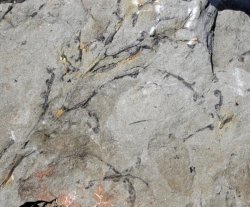  Another plant from the Zosterophyllum group is
Gosslingia from the Brecon Beacons in Wales. This one is
slightly younger than the plants of the Rhynie Chert. In Gosslingia
the sporangia are sitting scattered along the stems and the tips of the stems
are coiled. Click
here for more
information on this plant. Another plant from the Zosterophyllum group is
Gosslingia from the Brecon Beacons in Wales. This one is
slightly younger than the plants of the Rhynie Chert. In Gosslingia
the sporangia are sitting scattered along the stems and the tips of the stems
are coiled. Click
here for more
information on this plant.
The further the Devonian proceeds, the more forms appear and the higher
some plant species become. In the Middle Devonian tree 'ferns' appear with
a height of some meters. In the Late Devonian some plant groups develop the
ability to form thicker stems by means of secundary development. Thus we
see the appearance of woody stems enabling the plants to form trees. In the
Late Devonian there are already rather high trees up to 8 meters.
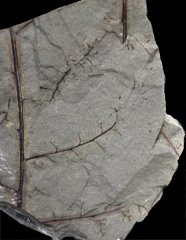  During
the Middle and the Late Devonian more species with leaves or leaflike structures
appear. These developed through 'webbing' of finely branched twigs, i.e.
the twigs became connected by intervening tissue. In the fernlike plant
Rhacophyton from the Belgian Late Devonian this is not yet the case.
However the branches in a way resemble fern leaves. The sporangia of this
plant are growing in clusters with a diameter of about 2.5 cm. During
the Middle and the Late Devonian more species with leaves or leaflike structures
appear. These developed through 'webbing' of finely branched twigs, i.e.
the twigs became connected by intervening tissue. In the fernlike plant
Rhacophyton from the Belgian Late Devonian this is not yet the case.
However the branches in a way resemble fern leaves. The sporangia of this
plant are growing in clusters with a diameter of about 2.5 cm.
Seed plants
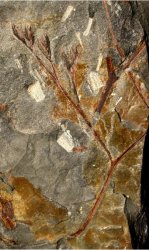  The oldest seed plants date from the Late Devonian.
The special feature of seeds is their being enveloped. In
Moresnetia (so called after the town of Moresnet
in Belgium) this envelope is not yet completely closed. It is placed around
the seed like a sort of calyx, leaving the top of the seed visible.
Moresnetia is one of the oldest seed plants in the world and the oldest
in Europe. For the time being, for new discoveries are made regularly. In
Belgium extraordinary well preserved specimens have been found, in which
even the seeds are visible. Click the photo! Some years ago a still
older precursor of the seed plants has been identified in the Middle Devonian
of Belgium. Click
here for
more details. The oldest seed plants date from the Late Devonian.
The special feature of seeds is their being enveloped. In
Moresnetia (so called after the town of Moresnet
in Belgium) this envelope is not yet completely closed. It is placed around
the seed like a sort of calyx, leaving the top of the seed visible.
Moresnetia is one of the oldest seed plants in the world and the oldest
in Europe. For the time being, for new discoveries are made regularly. In
Belgium extraordinary well preserved specimens have been found, in which
even the seeds are visible. Click the photo! Some years ago a still
older precursor of the seed plants has been identified in the Middle Devonian
of Belgium. Click
here for
more details.
The oldest seed plants were gymnosperms for the seeds were not yet embedded
in an ovary. From this kind of plants the many species of seed ferns developed
that grew in the coalswamps during the Carboniferous. And a
Moresnetia-like plant must have been the ancestor of all modern flowering
plants. Surely a plant to treat with respect.
Hans Steur
Top |